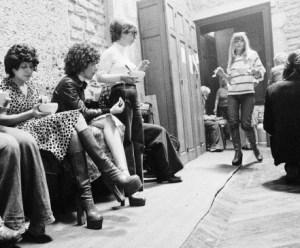That is how we ended up in the church, without knowing how it would all end, without knowing if we would get out dead or alive. But it was really the last thing that we could do to try and save our skin. – Maria de Lourdes
 Forty years ago today, the sex workers of Lyon, France protested the unrelenting torment the cops inflicted upon them by occupying the Church of St. Nizier. Despite its bawdy reputation in the English-speaking world, France has never been friendly to whores; beginning in the 16th century the French pioneered many of the laws and tactics used to harass us throughout the world to this day, and the Code Napoleon officially gave the police power to “control” prostitution (with results any regular reader could predict). The severity of the maltreatment ebbed and flowed throughout the 19th and early 20th centuries until the government decided to revenge its humiliation at the hands of the Nazis on the bodies of sex workers, and France became officially “abolitionist” in 1960.
Forty years ago today, the sex workers of Lyon, France protested the unrelenting torment the cops inflicted upon them by occupying the Church of St. Nizier. Despite its bawdy reputation in the English-speaking world, France has never been friendly to whores; beginning in the 16th century the French pioneered many of the laws and tactics used to harass us throughout the world to this day, and the Code Napoleon officially gave the police power to “control” prostitution (with results any regular reader could predict). The severity of the maltreatment ebbed and flowed throughout the 19th and early 20th centuries until the government decided to revenge its humiliation at the hands of the Nazis on the bodies of sex workers, and France became officially “abolitionist” in 1960.
By August of 1973 the cops’ depredations had become so severe a street protest was organized, but it did not end well and the police were only emboldened to make things worse. Early in 1975 they closed down the hotels de passe, cheap establishments where street workers took their clients, then proceeded to harry them with fines; the department decreed that each girl was to receive two or three fines per day, but because multiple cops were involved it could sometimes be five or more. If a woman went to pay her fines, she was intentionally delayed in the police station for several hours so she would lose most of her night; if she didn’t pay she would be arrested and jailed, and her children abducted by the state if there were no relatives to take them. Meanwhile, the tax department would present them with huge bills assuming numbers of clients that would fit comfortably in the masturbatory fantasies of “sex trafficking” fetishists.
Something had to give, and on June 2nd two sex workers named Ulla and Barbara led a group of 100 prostitutes to occupy a church in hopes of calling attention to their plight. They had an ally in Father Louis Blanc, who secured the cooperation of several other priests; they planned to occupy the Church of St.Bonaventure, but the police found out and began to prepare for mass arrests of the protesters as they arrived. Fortunately, Ulla was tipped off in time and diverted the protesters to St. Nizier instead; volunteers waited inside to direct each arrival out through the side doors while the cops waited outside in their cars, thinking they would wait until they could get a good crop of victims before springing their trap. Father Blanc remembers, “The police officers looked as if they were having fun in their cars. But after a while, they were having less fun because…’what is happening?’ We have disappeared! In the meantime the prostitutes have entered the Church of St. Nizier, where there are no police.” The priest at St. Nizier was Father Béal, and with his help over 100 whores were able to congregate there before the cops realized where they had gone.
By the evening of June 3rd, the news of the protest had spread across France, and over the next few days to other countries as well. Sex workers all over France began to occupy other churches; in Paris 200 whores occupied the Chapel of Saint Bernard. The media interviewed Ulla and other sex workers, allowing them to air their grievances for all to hear and they issued a “Letter to the People of Lyon” which read, in part,
…we haven’t taken up prostitution because we are depraved. Prostitution is the only means we have found to deal with the problems of life…People regard us as “dirty” or “abnormal” women, but at the same time they say we are needed…Prostitution is not forbidden under French law and theoretically we are citizens like everyone else. But because society is ashamed of the fact that it needs us, it treats us as criminals, people who can be subjected to the full repressive might of the police…
Most feminists of 1975 still actually supported women’s choices, and figures like Simone de Beauvoir spoke up for the sex workers; other activists protested outside the church in a show of solidarity. Their demands were simple; as stated in a pamphlet they circulated outside, “We will only leave the church once you have given us the guarantee that you will stop throwing us in jail each time you think there is a repeat offense. Our children do not want their mothers to go to jail.” The protesters told the media they wished to speak to Madame Giroud, then State Secretary for Women, but before the request could even be officially made Giroud refused, claiming this was not a women’s issue at all but rather the responsibility of the Minister of Interior; the latter politician, Michel Poniatowski, decided to reply with violence, and at 5 AM on June 10th ordered the police to remove the protesters from all of the churches.
In Paris and some other places, the removal was accomplished with the usual police tactics of smashing down doors and beating women with truncheons, but at St. Nizier they decided to use a trick. A cop called Father Béal pretending to be a reporter who wanted to speak to Ulla, and when the church door was unlocked to admit the priest with his fake message, armed cops sprang from hiding; they pushed him aside and swarmed into the building 120 strong, accompanied by 20 dogs and equipped with tear gas. Most of the women were simply ordered out, but Ulla and Barbara were beaten so severely they had to be hospitalized. Father Béal lodged a formal protest against the violation of the ancient principle of asylum, but Poniatowski replied that police could enter anywhere when “public order” was disturbed, citing a law from 1905 in support of his actions.
 But despite the government’s refusal to peacefully grant the demands, officials must have been anxious to avoid similar embarrassment in the future; the harassment stopped, the cops with the highest numbers of sex worker arrests were reassigned to other duties, and the ludicrous tax bills no longer appeared. By 1994 the culture had shifted sufficiently for “pimping” to be defined more narrowly, thus ending for a time the harassment of partners, roommates, adult children, etc with “avails” charges. Of course, that didn’t last long, and regular readers have seen the tide once again turn toward repression in the form of the “Swedish model“, laws against “looking like a whore” and even repeated parking fines for the vans from which most street workers now operate. But the protesters and their successors have not passively watched all this happen:
But despite the government’s refusal to peacefully grant the demands, officials must have been anxious to avoid similar embarrassment in the future; the harassment stopped, the cops with the highest numbers of sex worker arrests were reassigned to other duties, and the ludicrous tax bills no longer appeared. By 1994 the culture had shifted sufficiently for “pimping” to be defined more narrowly, thus ending for a time the harassment of partners, roommates, adult children, etc with “avails” charges. Of course, that didn’t last long, and regular readers have seen the tide once again turn toward repression in the form of the “Swedish model“, laws against “looking like a whore” and even repeated parking fines for the vans from which most street workers now operate. But the protesters and their successors have not passively watched all this happen:
…the whores began holding regular meetings and soon formed the French Collective of Prostitutes, on which the English Collective of Prostitutes was later modeled. Women in a number of other countries were also inspired to form groups, and a number of these came together with Margo St. James’ COYOTE to form the International Committee for Prostitutes’ Rights (ICPR), the organization whose work and example helped to win prostitution law reform in a number of European countries and provided an example which inspired similar campaigns in many other parts of the world. In a way, the modern sex worker rights movement was born on that June 2nd in Lyon, so we celebrate it now as International Whores’ Day.
I’ve written about this occasion before, but the greater detail in today’s column was made possible by a French-language documentary being broadcast today on both Radio France and Radio Belgium; it was produced by Australian sex worker rights activist Eurydice Aroney, who called it to my attention about six weeks ago and reminded me of it again recently. You can listen to the show at the link above, and Eurydice kindly provided me with this English translation of the transcript. She and I both think it’s very important that sex workers know about the history of our movement; please help us accomplish that goal by publicizing the documentary and this column on social media!
